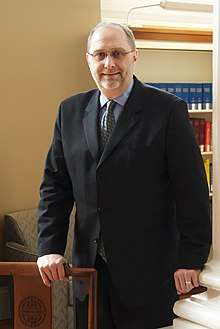Bruce Fuchs
Bruce A. Fuchs is an American immunologist and health science administrator.[1] He was the director of the Office of Science Education (OSE) at the National Institutes of Health.[2] On October 1, 2013, OSE ceased operations and Fuchs was reassigned.[3] He works as a health science administrator in the Office of Research Infrastructure Programs and oversees programs pertaining to career development. He is the primary contact for F30/F31 and SERCA K01 applications and the Diversity and Re-Entry Supplements. Fuchs' expertise is in immunology and brain immune interactions.[4]

Fuchs in 2007.
Selected publications
- Fuchs, Bruce A.; Albright, Julia W.; Albright, Joseph F. (1988). "β-Adrenergic receptors on murine lymphocytes: Density varies with cell maturity and lymphocyte subtype and is decreased after antigen administration". Cellular Immunology. 114 (2): 231–245. doi:10.1016/0008-8749(88)90318-8. PMID 2839301.
- Fuchs, Bruce A.; Campbell, Kerry S.; Munson, Albert E. (1988). "Norepinephrine and serotonin content of the murine spleen: Its relationship to lymphocyte β-adrenergic receptor density and the humoral immune response in vivo and in vitro". Cellular Immunology. 117 (2): 339–351. doi:10.1016/0008-8749(88)90123-2. PMID 2848630.
- Pruett, S. B.; Fuchs, B. A. (1993-07-01). "Morphine induces apoptosis in murine thymocytes in vivo but not in vitro: involvement of both opiate and glucocorticoid receptors". Journal of Pharmacology and Experimental Therapeutics. 266 (1): 417–423. ISSN 0022-3565. PMID 8392561.
- Fuchs, B. A.; Freier, D. O. (1994-09-01). "A mechanism of action for morphine-induced immunosuppression: corticosterone mediates morphine-induced suppression of natural killer cell activity". Journal of Pharmacology and Experimental Therapeutics. 270 (3): 1127–1133. ISSN 0022-3565. PMID 7932161.
- Street, N. E.; Fuchs, B. A.; Kasprowicz, D. J.; Ramer-Quinn, D. S.; Baker, R. A.; Sanders, V. M. (1997-05-01). "Differential expression of the beta2-adrenergic receptor by Th1 and Th2 clones: implications for cytokine production and B cell help". The Journal of Immunology. 158 (9): 4200–4210. ISSN 0022-1767. PMID 9126981.
- Bybee, Rodger W.; Fuchs, Bruce (2006). "Preparing the 21st century workforce: A new reform in science and technology education". Journal of Research in Science Teaching. 43 (4): 349–352. doi:10.1002/tea.20147. ISSN 0022-4308.
gollark: Well, do you know if they're available at sane prices in the UK?
gollark: Hmm.
gollark: Getting exotic techy stuff in the UK seems to be annoying.
gollark: There are no downsides, except the downsides!
gollark: I would get a PinePhone, but I don't know where I can actually get any or if they're purchaseable right now.
References
- Brown, Heidi Nolte (1993-11-21). "'Mini-Med School' Briefs Virginians on Health Care : Medicine: The 10-week course covers the brain, the immune system, microbiology, biochemistry, genetics and health policy. Students are not doctors in training; they just want to learn". Los Angeles Times. ISSN 0458-3035. Retrieved 2019-03-30.
- "2007 Short Course Videocast: Globalization and Science Education Policy". National Human Genome Research Institute (NHGRI). Archived from the original on 2019-03-30. Retrieved 2019-03-30.
- Mervis, Jeffrey (2013-09-27). "NIH Swears Off Science Education". Science. Retrieved 2019-03-30.
- "ORIP Staff Contacts". National Institutes of Health.
This article is issued from Wikipedia. The text is licensed under Creative Commons - Attribution - Sharealike. Additional terms may apply for the media files.